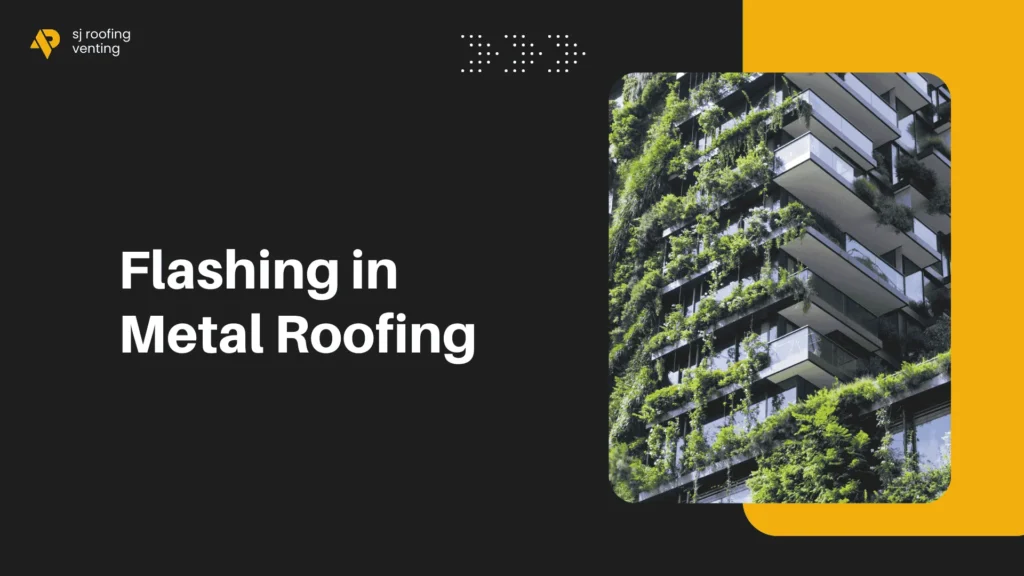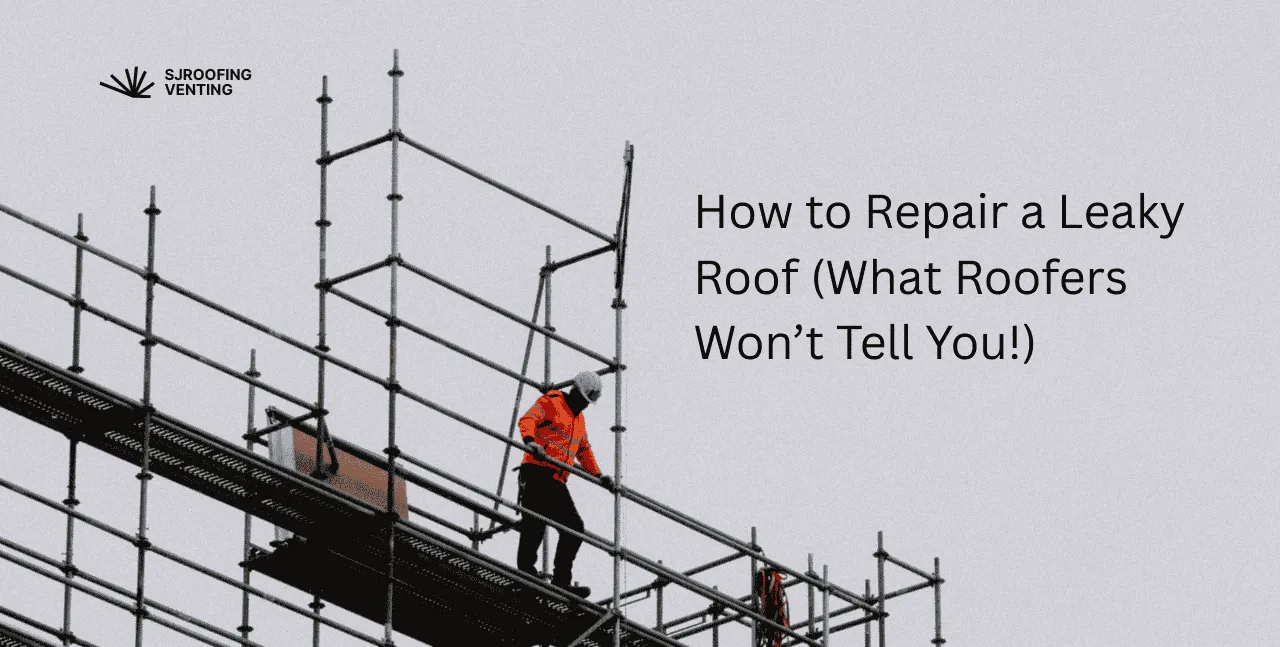A leaky roof might seem like just a small inconvenience at first, but it can quickly turn into a costly problem or even a nightmare. Water dripping from your ceiling can damage your roof, weaken the structure of your home, harm your insulation, and rot the wooden beams. Over time, this can lead to mold growth and even attract pests. This hidden damage can compromise your home’s safety and drastically reduce its value.
The real problem is that many roofing issues go unnoticed until the damage becomes severe — and most contractors won’t tell you about the simple, cost-effective fixes you can do before things get worse. In this guide, we’ll reveal what roofers often keep to themselves and show you step-by-step how to repair a leaky roof the right way.
When you call a roofer to inspect a leak on your roof, they usually won’t show you the real cause of the leak. Why? Because 95% of the time, it’s not the roof itself — it’s the flashing and drippage that are causing the problem.
And roofers don’t make good money fixing flashing. What are they going to charge you? $500? $800? It’s half a day of work, and they don’t profit much from it. That’s why most of them don’t even bother fixing it properly.
But here’s the good news:
95% of the time, you can fix the leak yourself — if you just know where to look and what to look for.
What Is Flashing and Why Does It Leak?
Before we dive into the problem, let’s explain flashing.
Many houses in the north and northeast have wood siding, clapboard, or vinyl siding with flashing tucked underneath it and the roof tucked underneath the flashing.
That is excellent — most of the time, it won’t leak.

But many homes with brick face, stucco, cement, or cinder block use a different type of flashing, and here’s where the problems start.
The Real Problem with Drippage and Flashing
When a roofer installs the membrane, it comes up the wall. But you can’t just leave the roof like that, or water will get in behind the membrane.
So they cut a slot into the brick, and then insert a drip edge flashing (drippage) with a lip, right into that slot.
After that, they apply caulking (doesn’t matter what kind — usually clear).
You’ll see this kind of caulking on chimneys a lot.
They just add a little caulking onto the slot where the transition is.
That’s all they do, and that will never last.
After two or three years, you’ll have a leak.
Flashing Failures in Action (Real Example)
Let’s take a closer look at a real-world roof leak repair situation that many homeowners and even some roofing contractors overlook. One of the most common causes of a so-called “roof leak” is actually not the roof itself, but the flashing. Flashing is a thin metal strip that gets inserted into a wall joint — it’s meant to direct water away from vulnerable areas of the roof. In a proper installation, the roofing material should go underneath the flashing, allowing water to flow over and away. A skilled roofer grinds a clean slot into the wall and embeds the flashing firmly into place. However, in many cases — especially with quick or cheap repairs — some roofers skip this step entirely and instead just apply caulking over the edge. That might look like a fix, but over time, that caulking separates due to weather exposure, heat, and water flow. Once it’s loose, water seeps behind the flashing, trickles behind the roof membrane, and ultimately leaks into the home. To the homeowner, it appears like a typical roof leak, but in reality, it’s a flashing issue at the wall — not a failed roof membrane. This is a major reason why many people search for “roof leak repair near me” or even call for emergency roof leak repair services when the true culprit could have been identified and fixed properly in the first place. Unfortunately, most roofing contractors won’t tell you this — not because they don’t know, but because it’s easier (and more profitable) to recommend a full roof patch or replacement instead of addressing a localized flashing failure. If you’re facing persistent leaks, especially near walls or chimneys, it might be time to get a second opinion — and ask about the flashing. Whether you’re in New Jersey looking for roof leak repair NJ or simply want to understand how to repair roof leak issues more effectively, knowing about flashing failures is crucial to avoiding costly repeat jobs. This type of knowledge is essential for homeowners dealing with leaking roof repair, especially when considering roof leak repair cost and the value of doing the job right the first time.
The Most Common Roofer “Fix” (That Doesn’t Work)
They’ll just tell you, “Oh, you need to [blank]” (they’ll suggest something vague), and they just caulk the flashing.
And guess what?
That only lasts 1–2 years, and then they’re gone, and you’re left with a leak again.
Let’s show you how to actually fix this the right way.
Understanding the Drippage Problem
Now we’re back at this roof section again.
The problem is the drippage. Often, the membrane comes loose from the drippage — especially where two drip edges overlap at a joint. Water seeps in and reaches the fiberboard.
Now, fiberboard is very soft wood fibers, and when it gets wet, it rots.
Here’s what happens:
- Water gets in
- Fiberboard gets soft
- Screws holding it down don’t move, but the board compresses
- Screws start to push up through the membrane
That’s what causes bumps and leaks on your roof.
What Happens When Fiberboard Gets Wet
Look at what we did:
We wet the fiberboard overnight to show you how it behaves.
The screws don’t go down because the board sinks, and the screws press through the membrane, causing bulges and leaks.
Let me show you how we fixed it…
Real Repair: Fixing Screws and Seams
We came back to the model roof. The metal drip edge came loose.
Water got under the roof and softened the board.
Now the screws are pushing up.
So, we pounded those screws back down.
Some are rusted and break, but most can be hammered in.
We did this across the whole area.
Now let’s fix it the right way.
Step-by-Step: How to Fix a Leaky Roof Properly
Here’s what we did:
- Cut the fleece (reinforcement fabric) into 2-inch strips
No need for 4-inch strips — it just wastes material - Use Turbo Poly Seal (liquid flashing product)
- Paint over the transition between the metal edge and rubber membrane
- Apply the 2-inch fleece strip onto it
- Press it down — and it’s sealed for life!
This is a permanent fix.
You’ll never have to worry about this leak again.
Fixing Nail Holes and Seams
We also had a screw hole where we hammered it down.
Just take a small dab of Turbo Poly Seal, patch it with fleece, and it’s done.
Also, we found a seam that opened up — likely from stress due to leaking.
We simply painted over it with the sealant and patched it.
That’s it — done. Beautiful. Seam fixed.
Final Flashing Repair (Do It Right)
Now back to the flashing…
Here’s what you cannot do:
- You cannot apply sealant over loose paint
- Paint will come off — your patch will fail
So here’s what to do:
- Use a grinder to clean the surface
- Remove all loose or dusty paint
- Clean the flashing and wall area thoroughly
Fixing Brick Wall Leaks (Bonus Tip)
There are other places leaks can occur — like brick walls where grout has worn out.
Here’s how to fix it:
- Use Turbo Poly Seal (again — amazing stuff!)
- Apply a thick coat over the crack
- Let it cure for 24 hours
- Then, paint over it
Water cannot get in behind it ever again.
| Step No. | Action | Description |
|---|---|---|
| 1 | Identify the Leak Source | Inspect your attic, ceiling, and roof surface to find exactly where water is entering. Look for water stains, damp insulation, or daylight through gaps. |
| 2 | Clear the Area | Remove debris, leaves, or branches from the roof to ensure a clear working surface. |
| 3 | Check for Damaged Shingles | Look for cracked, curled, or missing shingles and note their locations. |
| 4 | Remove Damaged Materials | Carefully lift and remove the damaged shingles or roofing material without harming nearby areas. |
| 5 | Repair Underlayment | Replace or patch any torn or rotted underlayment to restore a solid waterproof layer. |
| 6 | Install New Shingles | Place new shingles that match your existing roof, securing them with proper nails and sealant. |
| 7 | Seal Around Roof Penetrations | Apply roofing sealant around vents, chimneys, and skylights to prevent leaks in these vulnerable spots. |
| 8 | Check Flashing | Inspect and repair or replace damaged flashing to ensure tight water protection along joints and edges. |
| 9 | Test the Repair | Spray water over the repaired area with a hose to confirm the leak is sealed. |
| 10 | Maintain Regularly | Schedule seasonal inspections and clean your roof to prevent future leaks. |
Conclusion
Most roof leaks aren’t caused by the roof itself.
They’re caused by:
- Faulty flashing
- Damaged drip edges
- Wet and soft fiberboard
- Loose seams or screws
Why does my roof leak during heavy rain?
Heavy rain can expose weak spots, damaged shingles, or poor flashing in your roof.
How can I fix a leaking roof from the inside?
Use a roof patch or tarp to temporarily stop the leak until you repair it from outside.
Can I repair a leaky roof without replacing it?
Yes, sealing damaged areas or replacing a few shingles can fix it without full replacement.
How can I repair a leaky roof myself?
Identify the leak source, clean the area, and seal or replace damaged parts.
How do I repair a leaky roof from the inside?
Place a waterproof tarp under the leak and apply roof sealant as a temporary fix.
How can I fix a leaking roof from the outside?
Replace damaged shingles, reseal flashing, or apply roof sealant to the problem area.
What is roof leak repair sealant?
It’s a waterproof product used to seal cracks, gaps, and holes in roofing material.

Hello! I’m Abdullah, a passionate professional in the field of construction and roofing. I am the proud owner of SJ Roofing & Venting, a leading construction company based in New York. With years of hands-on experience, I write about various construction methods, techniques, and industry insights to share my knowledge and help others in the field. I’m also the founder and main contributor of this website.

